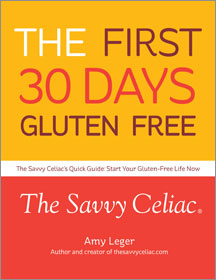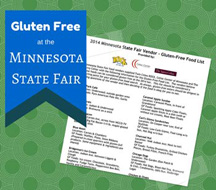New Developments on Arsenic in Rice – FDA’s Investigation
September 6, 2013 by Amy Leger | G+ Amy LegerNearly one year ago, I published a lengthy post on the concerns about arsenic found in rice. The article stemmed from a Consumer Reports investigation in 2012 that found arsenic in different forms of rice. My post raised the question that if there are unacceptable levels of arsenic in rice, how does that impact people on a gluten-free diet who often eat a lot of rice.
Friday, the Food and Drug Administration addressed the arsenic levels in rice saying the arsenic levels found in rice is not an immediate health risk for the general public.
The FDA said in its announcement during its testing of 1300 products containing rice, it found that in rice grains: “average levels of inorganic arsenic ranged from 2.6 to 7.2 micrograms per serving, with instant rice at the low end of the range and brown rice at the high end”. For rice products the levels ranged from .o1 to 6.6 micrograms per serving. with infant formula on the low end and rice pasta at the high end. The Consumer Reports study measured parts per billion, so the numbers in the CR report from last year and the current numbers from the FDA are not quite “apples to apples”.
But the overall findings are similar– that brown rice and brown rice pasta, tend to have the higher arsenic levels.
The FDA also stated that while the immediate effects are not an issue, they say they don’t know about long-term affects. That is the area of study they will focus on now. “These are the next steps: To look at exposure levels, to analyze the risk, and determine how to minimize that risk for the overall safety of consumers, including vulnerable groups like children and pregnant women,” says Suzanne C. Fitzpatrick, Ph.D., senior advisor for toxicology in FDA’s Center for Food Safety and Applied Nutrition. Eventually their assessment will be available for public comment. The FDA says that won’t happen for “several months”.
Arsenic in general terms is a known human carincogen. The Consumer Reports article from last year referenced the International Agency for Research on Cancer which has arsenic listed in its list of 100 Group 1 carcinogens. ”It is known to cause bladder, lung and skin cancer in humans, with the liver, kidney, and prostate now considered potential targets of arsenic-induced cancers,” the article said.
I hope the FDA considers people with celiac disease and non-celiac gluten sensitivity when furthering this research. Companies and consumers make rice a default grain when preparing a gluten-free diet. As a result, we eat a lot of it. Yes, there are other grains we could and probably should be eating. But that may not be the case for many of us.
What are your thoughts on this? Have you reduced your rice intake since the initial report? What do you think of the new information from the FDA?
Tags: arsenic, celiac, FDA, gluten-free, rice



September 7th, 2013 at 11:37 am
When the story first broke, I was alarmed. I don’t really trust the FDA- not that they’d intentionally try to hurt us, but they also consider economic concerns in their recommendations. What will the news do to the rice market. They did say that we shouldn’t stop eating rice (I saw that as “rice market” concerns) but if we were concerned we should just cook rice using more water. I eat two pounds of brown rice every week. I didn’t stop, but I did switch to using more water. The recipe at Saveur is excellent – 1 cup rice, 12cups water – though washing away some of the arsenic with all that water also washes away nutrients, but I had to do something.
September 8th, 2013 at 11:11 am
Hi Amy
I too wrote an article about arsenic in rice for the Examiner.com last fall: http://www.examiner.com/article/arsenic-your-rice-should-you-be-concerned . I found out through my research that other more important sources of arsenic in our diet are tap water and greens (or any plant that more readily uptakes water from soil). Around the time of the Consumer Report article, I was being tested for heavy metal toxicity. As it turns out, I am high in arsenic. I then began limiting any food or liquid high in arsenic. I still intake some organic brown rice because I do not do well with most other grains but I do try to limit it to twice a week.
Kim
September 9th, 2013 at 9:37 am
Thank you Dave for your suggestions and insight. I just want them to consider celiac and gluten free folks as a potential “high risk” group to see if eating too much rice long term could be an issue. I like the idea of washing away at least some of the harmful stuff with the extra water. Good suggestion!
September 9th, 2013 at 9:37 am
Thanks Kim. it really is an interesting subject the more you dig into it. I hope you’re feeling better….